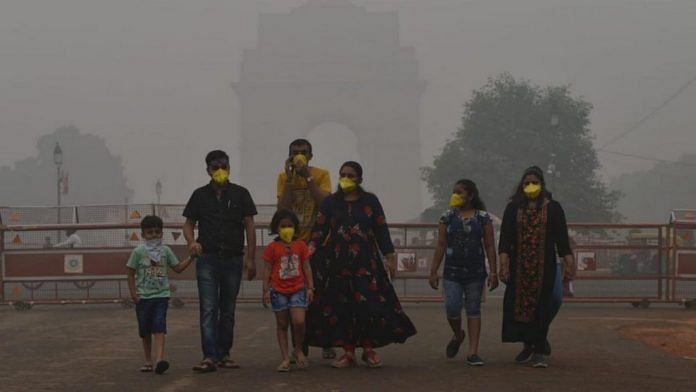New Delhi: The national capital’s air quality was in the very poor category on Tuesday morning, the first time this season, with calm winds and low temperatures allowing accumulation of pollutants.
According to the Ministry of Earth Sciences’ Air Quality Early Warning System for Delhi, an increase in farm fires in Punjab, Haryana and neighbouring regions of Pakistan is also going to impact the air quality in Delhi-NCR.
The city recorded an air quality index (AQI) of 304 at 9:30 am, which falls in the very poor category. The 24-hour average AQI was 261 on Monday, the worst since February. It was 216 on Sunday and 221 on Saturday.
Wazirpur (AQI 380), Vivek Vihar (AQI 355) and Jahangirpuri (AQI 349) recorded the highest pollution levels.
An AQI between 0 and 50 is considered ‘good’, 51 and 100 ‘satisfactory’, 101 and 200 ‘moderate’, 201 and 300 ‘poor’, 301 and 400 ‘very poor’, and 401 and 500 ‘severe’.
A senior scientist at the Delhi Pollution Control Committee said the dip in the air quality can be attributed to low wind speed and temperatures which allowed accumulation of pollutants.
Stubble burning has also increased in neighbouring states. Also, the ventilation index is low, he said.
Ventilation index is the speed at which pollutants can get dispersed. A ventilation index lower than 6000 sqm/second, with average wind speed less than 10 kmph, is unfavourable for dispersion of pollutants.
PM10 levels in Delhi-NCR stood at 300 microgram per cubic meter ( g/m3) at 9 am — the highest this season so far, according to CPCB data. PM10 levels below 100 g/m3 are considered safe in India.
PM10 is particulate matter with a diameter of 10 micrometers and is inhalable into the lungs. These particles include dust, pollen and mold spores.
The levels of PM2.5 finer particles which can even enter the bloodstream were 129 g/m3. PM2.5 levels up to 60 g/m3 are considered safe.
NASA’s satellite imagery showed a large cluster of fires near Amritsar and Firozpur in Punjab and Patiala, Ambala and Kaithal in Haryana.
According to the System of Air Quality and Weather Forecasting and Research, farm fires contributed 3 percent particulate matter to Delhi’s PM2.5 concentration on Monday.
Also read: Delhi starts efforts to fight pollution with plan to give free stubble decomposer to farmers
It is likely to be negligible for the next two days due to a change in the wind direction from northwesterly to southeasterly, the government agency said.
On Tuesday morning, the maximum wind speed was 4 kilometers per hour, according to the India Meteorological Department.
Low temperatures and stagnant winds help in accumulation of pollutants near the ground, affecting air quality.
With Delhi-NCR bracing for months of poor air quality, experts have warned that high levels of air pollution can aggravate the COVID-19 pandemic.
Severe air pollution in Delhi is a year-round problem, which can be attributed to unfavourable meteorological conditions, farm fires in neighbouring regions and local sources of pollution.
According to an analysis by the Council on Energy, Environment and Water, a Delhi-based think tank, transportation contributes the most — 18 to 39 percent — to Delhi’s air pollution.
Road dust is the second largest source of air pollution in the city (18 to 38 percent), followed by industries (2 to 29 percent), thermal power plants (3 to 11 percent) and construction (8 percent).
This year, the Delhi government has launched a massive anti-air pollution campaign — Yuddh Pradushan Ke Viruddh’ — which is being led by Chief Minister Arvind Kejriwal and Environment Minister Gopal Rai.
A green war room with a 10-member expert team has been set up at the Delhi Secretariat to monitor the steps being taken to deal with high levels of air pollution in winters.
The environment department has also taken stern action against project proponents at large construction and demolition sites flouting dust control norms.
The government will also start the spraying of Pusa bio-decomposer solution in non-basmati rice fields in the national capital, on Tuesday.
The solution, experts say, can turn the stubble into manure in 15 to 20 days and therefore, can prevent stubble burning.
Starting October 15, stricter measures to fight air pollution will also come into force in Delhi and its neighbourhood as part of the Graded Response Action Plan, which was first implemented in Delhi-NCR in 2017.
Also read: Delhi Environment Minister Gopal Rai launches ‘green war room’ to monitor pollution levels



